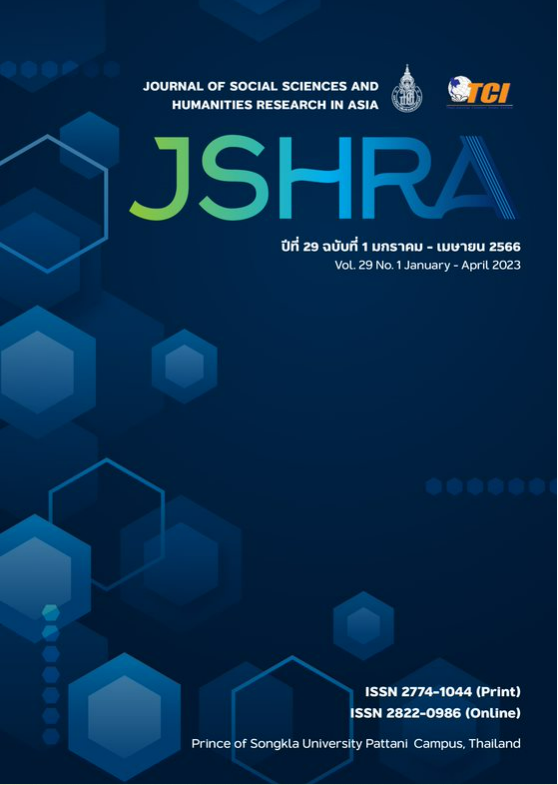Can TED Talks Help Improve Undergraduate Non-English Major Thai EFL Students' Listening and Speaking Competencies?
Keywords:
English as a Foreign Language, Listening and Speaking Skills, TED Talks, Thai UndergraduateAbstract
The test results (mid-semester and final examinations) of various English courses indicate a clear majority of non-English major undergraduate students studying at the university where the current study was undertaken leave the university after four years without acquiring the required proficiency in English. This condition can deprive them of local and international social and educational opportunities. Given the situation described above, this study was conducted to explore the effectiveness of an instructional intervention supplemented with authentic materials that included TED Talks videos to enhance English as a Foreign Language (EFL) tertiary-level learners' listening and speaking skills in Thai tertiary education. The study employed a pre-test and post-test research design in which two study groups (Teaching Chinese as a Foreign Language (n = 44) and Teaching Elementary Education (n = 38) were chosen using a random purposive sampling technique. The study groups were instructed with TED Talks: Keynote 4 teaching materials for one semester, and the study used two research instruments (pre-test and post-test). The pre-and post-test data were analyzed using descriptive and inferential statistical tests. The results were statistically significant at .05, indicating an improvement in listening and speaking competencies equivalent to the B2 level in the Common European Framework of Reference for Languages (Council of Europe, 2020) for both groups. In addition, a large effect size between variables was reported. This means that this study is practically significant. Assuming the study's positive outcomes, it can be concluded that the instructional intervention supplemented by TED Talks: Keynote materials can effectively enhance non-English major EFL undergraduate learners' listening and speaking competencies.
References
Brown, G., & Yule, G. (1983). Teaching the spoken language. Cambridge: Cambridge University Press.
Byrnes, H. (1984). The role of listening comprehension: A theoretical base. Foreign Language Annals, 17(4), 317-329. https://doi.org/10.1111/j.1944-9720.1984.tb03235.x
Cohen, J. (1988). Statistical power analysis for the behavioral sciences (2nd ed.). HillS.D.ale, NJ: Lawrence Erlbaum.
Council of Europe. (2020). Common European framework of reference for languages: Learning, teaching, assessment. Cambridge, UK : Press Syndicate of the University of Cambridge.
Dörnyei, Z., & Chan, L. (2013). Motivation and vision: An analysis of future L2 self-images, sensory styles, and imagery capacity across two target languages. Language Learning, 63(3), 437-462.
Feyten, C.M. (1991). The power of listening ability: An overlooked dimension in language acquisition. The Modern Language Journal, 75(2) 173-80. https://doi.org/10.1111/j.1540-4781.1991.tb05348.x
Field, J. (2002). The changing face of listening. In J.C. Richards, & W.A. Renandya (Eds.). Methodology in language teaching: An anthropology of current practice (pp. 242-247). Cambridge: Cambridge University.
Furmanovsky, M. (1996). Content video in the EFL classroom. Ryukoku University: 6p (ERIC 410-755).
Gardner, R.C. (2010). Motivation and second language acquisition: The socio-educational model. New York: Peter Lang.
Hunsaker, P., & Allessandra, A. (1986). The art of managing people. New York: Simon & Schuster Inc.
Jaiyai, S., Torwong, P., Usaha, S., Danvirattana, A., Luangthongkam, S., & Piyadamrongchai, R. (2005). The existing situations and problems relating to foreign language teaching andlearning in the Northeastern part of Thailand (Educational Region 5). Bangkok: Thailand Research Fund.
Khamkhien, A. (2011). Quantitative and qualitative views of Thai EFL learners’ learning oral communication skills. Academic Research International, 1(1), 90-103.
Kim, H.S. (2015). Using authentic videos to improve ELF students’ listening comprehension. International Journal of Contents, 11(4), 15-24.
Krashen, S.D. (2019). The compelling (not just interesting) input hypothesis. The English Connection. Retrieved August 6, 2022, from http://www.S.D.krashen.com/content/articles/ the_compelling_input_hypothesis.pdf
Krashen, S.D., & Terrel, T.D. (1998). The natural approach: Language acquisition in the classroom. London: Prentice Hall International.
MacIntyre, P.D. (2002). Motivation, anxiety, and emotion in second language acquisition. In P.Robinson (Ed.), Individual differences and instructed language learning (pp. 45-68). Philadelphia: John Benjamins.
Mathew, N.G., & Alidmat, A.O.H. (2013). A study on the usefulness of audio-visual aids in EFL classroom: Implications for effective instruction. International Journal of Higher Education, 2(2), 86-91.
Mayer, R.E. (2021). Multimedia learning. Cambridge: Cambridge University Press.
McLeod, S.A. (2019). What does effect size tell you? Simply psychology. Retrieved July 10, 2022, from https://www.simplypsychology.org/effect-size.html
Newkirk, W., & Linden, R. (1982). EMS management: Improving communication through active listening. Emergency Medical Services, 11(7), 8-11.
Ortega, L. (2007). Meaningful L2 practice in foreign language classrooms: A cognitive-interactionist SLA perspective. In M. DeKeyser (Ed.), Practice in a second language: Perspectives from applied linguistics and cognitive psychology (Report). Cambridge: Cambridge University Press.
Pittenger, K.K.S., Miller, M.C., & Mott, J. (2004). Using real-world standards to enhance students’ presentation skills. Business Communication Quarterly, 67(3), 327-336. https://doi.org/10.1177/1080569904268084
Rashtchi, M., & Mazraehno, M.R.T. (2019). Exploring iranian EFL learner’s listening skills via ted talks: Does medium make a difference? Journal of Language and Education, 5(4), 81-97. https://doi.org/10.17323/jle.2019.9691
Richards, J.C. (2006). Developing classroom speaking activities; from theory to practice. Retrieved August 6, 2022, from www.cambridge.com.mx/site/EXTRAS/jack- CD.pdf
Richards, J.C. (2008). Teaching listening and speaking: From theory to practice. Cambridge University Press, USA.
Salem, A.A.A.M. (2019). A sage on a stage, to express and impress: TED talks for improving oral presentation skills, vocabulary retention, and its impact on reducing speaking anxiety in ESP settings. English Language Teaching, 12(6), 146-160.
Social Science Statistics. (n.d.). Effect size calculator for t test. Retrieved August 15, 2022, from https://www.socscistatistics.com/effectsize/default3.aspx
Stephenson, H., Lansford, L., Dummelt, P., Walker, R., & Blass, L. (2017). TED talks: Keynote 4. Washington, DC: National Geographic/(ELT).
Stempleski, S., & Tomalin, B. (1995). Video in action: Recipes for using video in language teaching. Hoboken, NJ: Prentice Hall.
Takaesu, A. (2014). TED talks are an extensive listening resource for ESP students. Language Education in Asia, 4(2), 150-162. https://doi: 10.5746/Leia/13/V4/12/A05
Vandergrift, L., & Goh, C.C.M. (2012). Teaching and learning second language listening: Metacognition in action. New York: Routledge.
Vandergrift, L. (2002). Listening: Theory and practice in modern foreign language competence. Subject Centre for Languages, linguistics and area studies good practice guide. Retrieved July 21, 2022, from http://www.llas.ac.uk/resources/gpg/2241
Waluyo, B. (2019). Examining thai first-year university students’ english proficiency on CEFR levels. The New English Teacher, 13(2), 51-71.
Wood, D. (1999). Aspects of video movie english teaching. Journal of Chikushi Jogakuin University, 11, 93-104 (ERIC ED427548).
Woottipong, K. (2014). Effect of using video materials in the teaching of listening skills for university students. International Journal of Linguistics, 6(4), 200-212.











